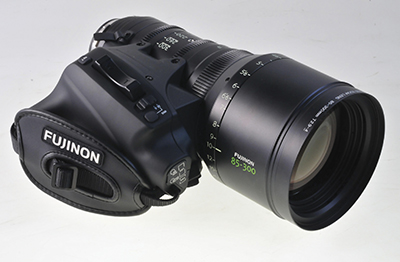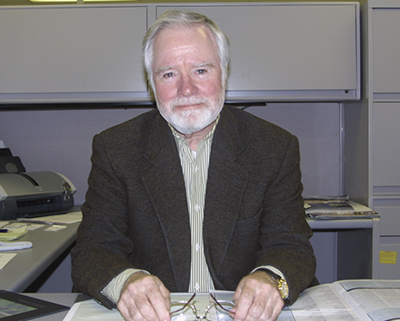Lensmakers Advance Versatility in The Coming 4K Era

Fujinon’s Premier PL 85-300 Cabrio lens
SEATTLE—Just as with a chain being only as strong as its weakest link, any 4K video system is only as good as its weakest component. Lens makers for the broadcast and digital cinematography marketplace are working overtime to make certain the weakest link in 4K isn’t in their optics.
Thom Calabro, director, marketing and product development at Fujifilm’s Optical Devices Division in Wayne, N.J., said his company saw an opportunity to make a high-quality 4K zoom lens in an ENG lens form factor. There are times that the ENG-style integrated hand-grip and zoom-motor design is preferable to a cine-style lens assembly. “Especially if they’re moving around, doing ‘run and gun’ shooting. And if you’re doing any kind of naturetype shooting, you can’t have an assistant get the tape measure out and measure to the subject,” because it’s too far away or perhaps too dangerous.
Fujifilm’s answer to this challenge is its Fujinon Cabrio series of PL-mount lenses, a 19-90mm zoom lens and the newly introduced PL 85-300 zoom. Both provide coverage for large sensor cameras, with superior glass elements and upper end optical design features, such as a nine-bladed iris. And it comes with an integrated but removable hand-grip and zoom-motor.
Calabro explained: “…we had a lot of people say ‘I like the lens, but I’m not going to operate like a typical ENG lens, I want to be able to put my follow focus, my matte box, all my other typical cine gear on my rig, and use it that way, because that’s what I’m comfortable with.’”

Larry Thorpe of Canon.
For those using the lens to shoot cine style, it has large focus ring markings and a 200-degree rotation of the focus ring to provide fine focus. The iris is also calibrated in T-stops.
Calabro thinks some cine-style shooters will find they like using the Cabrio lens’ own motor. “You can actually plug in your wireless controls directly into our onboard servo, and control the lens that way, and then you don’t have to add the rods for your motors and all the cabling that entails, you can plug in directly and use your own wireless controls with our Fuji motors.”
Get the TV Tech Newsletter
The professional video industry's #1 source for news, trends and product and tech information. Sign up below.
“A lot of the cinema people initially kind of looked at [the Cabrio lens] and, I wouldn’t say they turned their noses up, but they certainly cast a wary eye on it when they first saw it. But now it’s certainly taken off.”
QUALITY AT A LOWER PRICE
Thales Angenieux, with a long history in film lenses and broadcast camera lenses, took aim at a segment of the large single-sensor market that asked for smaller form factor lenses that were cost effective. The result is the company’s Optimo DP Series, including a 16-42mm and a 30- 80mm zoom lens.
“Our Optimo DP Series is a true cine lens design that offers filmmakers more options for cost-efficient lenses with lasting quality,” said Eva Paryzka, U.S. sales manager, cinema products for Thales Angeniex. “As our higher end line, Optimo DP Series feature Angenieux’s unique mechanical design for precise zoom and focus, fast aperture of T2.8, 320-degree focus rotation and no breathing. Our design philosophy behind the development of the DP line was to meet the needs of filmmakers using the newest generation cameras with lighter and more compact lenses, each weighing just 4.2 pounds.”
In designing the DP Series, Angenieux faced the challenge of delivering a cost-efficient lens that lived up to the quality standards the company has long been known for.
“Every Angénieux lens is hand-finished for our well-known precision and quality,” said Paryzka. “With some of the highest-end lenses in the industry, we were able to leverage the same manufacturing skills and experience for the DP line. With a few expertly designed modifications and adjustments, including a more value-driven rear group design and a slower T stop, we were able to meet a lower price point without sacrificing the quality Angénieux is known for.”
4K TESTS
Larry Thorpe, senior fellow at Canon’s Imaging Technologies & Communications Group, Professional Engineering & Solutions Division in Lake Success, N.Y. said the company has immersed itself in sports applications for 4K lenses, having done a series of tests already this year with customers like Fox Sports, the Major League Baseball Network, ESPN and Turner Sports.
“They’re all exploring the use of 4K cameras to create rather large, wide angle, very high resolution imagery that are piped into their trucks,” he said. “Then an operator in there can grab ahold of that video, and using some of their more contemporary tools that you saw at NAB, reach in and extract, digitally zooming, an HD portion of that imagery.”
By providing a replay in slow- or stop-motion HD-resolution image, even when zooming into only a portion of the 4K frame, viewers can clearly see whether the ball or player’s foot, for instance, was in-bounds or out-of-bounds.
Some of the applications use a locked down camera that doesn’t require an operator, but other users want an operator-run camera. This requires the lensmakers to provide the same feel of operation, zoom and focus control, from lenses and cameras that were designed for digital cinematography. “It thrust us squarely into systemization that we’ve never been in before,” said Thorpe.
For now, he said, Canon’s CN-E 30- 300mm 10x1 zoom has been very popular for these tests. When questioned about whether 4K box lenses were coming, he said: “That’s a big discussion we’re having with all of these folks. There’s not quite a consensus on that. We’re listening very, very closely and it’s not impossible that a box lens might emerge at some point, but it’s too early to really pinpoint that now.”
Thorpe noted that Canon’s C500 4K camera has been popular for these tests because it delivers the RAW video as a SMPTE standard 3G SDI signal that popular transport systems already utilized in the remote trucks can handle. Iris control, which is usually done in the truck for OB broadcasts, can travel to the camera and lens combination on the reverse path.
As 4K imaging becomes the path to the future for both broadcast and cinema production, lens makers are charging ahead to make sure their products measure up.
